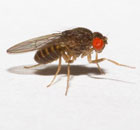Gene Editing Reduces Hemophilia Symptoms in Mice

- Katherine High
- The Children’s Hospital of Philadelphia
The blood clotting disorder hemophilia B is caused by defects in a clotting factor called Factor IX. Researchers have corrected the disorder in mice by repairing the gene with a scissor-like molecular tool that snips out the defective region of the gene. The tool, called a zinc-finger nuclease, specifically targets the defective segment of DNA and is administered along with a flawless segment of the Factor IX gene. Once the defective segment is excised, the cell’s DNA repair proteins take over, copying the correct version of the gene. After treatment with Factor IX zinc-finger nucleases, mice with severe hemophilia B gained enough clotting factors to downgrade their disease from severe to mild.
Finding Pancreatic Cancer in Its Infancy

- Bert Vogelstein
- The Johns Hopkins University School of Medicine
Pancreatic cancer is relentlessly lethal; fewer than 5 percent of patients survive 5 years after diagnosis. But a new genetic analysis demonstrates that pancreatic tumors are no more aggressive than other tumors. After comparing the genetic mutations present in pancreatic tumors and distant metastases from the same patients, researchers concluded that it takes an average of 11.7 years for a mature pancreatic tumor to form after the appearance of the first cancer-related mutation. Pancreatic tumors usually produce no symptoms until they have spread. The new data suggest that a genetic analysis of a blood or stool sample to pick up early cancer-causing mutations might provide the time needed to intervene successfully.
Spliceosome Caught on Camera

- Melissa Moore
- University of Massachusetts Medical School
Spliceosomes prepare the genetic code to be translated into proteins by chopping out long strings of genetic material and stitching the remaining segments back together. The spliceosome has five major parts that dynamically interact with one another and with the RNA that they process. In human cells, these components must find one another and assemble into a spliceosome millions of times a day to keep protein production moving along. By labeling each component with a different fluorescent tag and tracking the individual molecules with a microscope equipped with four different-colored lasers, researchers have now captured the massive spliceosome assembly on camera. They witnessed a continuous shifting of parts, which suggests that the assembly process can be shut down or reversed once it has begun.
The Tangled Biology of Aggression

- David Anderson
- California Institute of Technology
You can be a lover or a fighter—but not at the same time, and studies in mice are hinting at why. Examining the activity of neurons in a tiny region buried deep within the animals’ brains, researchers found that the neural circuits controlling aggression and mating are closely intertwined. Specifically, postdoctoral researcher Dayu Lin in Anderson’s lab recorded the activity of individual neurons in the ventromedial nucleus of the hypothalamus. He found that one subset of neurons fired during aggressive behavior, and a partially overlapping but distinct set fired during mating. Many of the aggression neurons were inhibited during mating. However, when the researchers overcame this inhibition in male mice by artificially stimulating the neurons associated with aggression, the mice attacked females rather than mating with them. The close relationship between the two groups of neurons may normally help suppress aggressive behavior during mating.
Missing DNA Key to Human Evolution

- David Kingsley
- Stanford University School of Medicine
Among the features that set humans apart from other animals are 510 segments of regulatory DNA that are present in other species but surprisingly missing from the human genome. Researchers showed that two of the missing sequences help explain why humans lack the sensory whiskers and spiny penises possessed by many other mammals, but have evolved much larger brains. The loss of specific regulatory sequences likely contributed to the evolution of these and other human traits. The findings mirror evidence from other species indicating that changes to regulatory regions of DNA, rather than to genes themselves, underlie many of the features that organisms acquire during evolution.
What It Takes to Control HIV Naturally

- Bruce Walker
- Massachusetts General Hospital
A small fraction of people who are infected with HIV can control it without drugs; they are now helping scientists learn about potential ways to fight the virus. The first genome-wide association study of these individuals, called elite controllers, has identified a few amino acids that seem to predict a person’s ability to keep the virus in check. Those amino acids help determine how the immune system recognizes HIV-infected cells. The findings indicate what an effective natural immune response is and how it is induced—information that could help generate more effective vaccine-induced immune responses to prevent or treat HIV.
Spotting Cancer Stem Cells in the Crowd

- Elaine Fuchs
- The Rockefeller University
Stem cells can differentiate into multiple cell types and divide in perpetuity, two qualities that make them potential tools for regenerative medicine. Cancer stem cells, on the other hand, use the same characteristics to wreak havoc. Two signaling pathways that scientists found are critical to regulating the growth of squamous cancer stem cells—which can seed tumors in the skin, head, neck, lungs, esophagus, and other tissues—will now help researchers discriminate between those menacing cells and normal stem cells in the skin. Interfering with these cancer-specific pathways could lead to drugs that destroy cancer stem cells more effectively while sparing normal stem cells.
Searching for a Marker for PTSD

- Kerry Ressler
- Emory University School of Medicine
A single terrifying event can cause deep and lasting damage in some people, while leaving others psychologically unharmed. Now, researchers have discovered that a protein called PACAP (pituitary adenylate cyclase activating polypeptide) is present in higher levels in the blood of women with post-traumatic stress disorder than in those who experienced traumatic events but had not been diagnosed with the disorder. Experiments with mice suggest that PACAP activity in regions of the brain that mediate fear and stress increases in the presence of estrogen. The researchers say the results could lead to a blood test for susceptibility to PTSD in women. PACAP levels were not associated with PTSD symptoms in men.
Antibody Recognizes Many Strains of Flu

- Stephen Harrison
- Harvard Medical School
Strains of influenza virus change so much that a new vaccine must be developed every year to prime patients’ immune systems to target the current threat. After studying a patient with an unusually well-equipped immune system, researchers think it may be possible to ready the body to fight off a wide variety of influenza strains. From that individual’s army of immune cells, scientists identified a single antibody that recognized and blocked 30 of 36 strains of influenza that have arisen since 1988. The antibody binds so tightly to a surface pocket on the virus that recognizes human cells that its binding appears not to be strongly affected if the surrounding area mutates. The researchers hope to use this information to design an influenza vaccine that provides broad protection against many strains of influenza.
New Targets for Melanoma Therapies

- Leonard Zon
- Children’s Hospital Boston
Researchers are using a tiny, translucent fish to identify cellular signals that can drive the development and progression of melanoma. After analyzing more than 2,100 zebrafish tumors, researchers identified a single enzyme, SETDB1, that seemed to accelerate melanoma. They followed these experiments with an analysis of human melanoma cell lines and found that the SETDB1 gene was overactive in 70 percent of those cells. Zebrafish also led researchers to a second molecule, DHODH, which is involved in formation of the stem cells that give rise to melanoma. This protein, which helps convert DNA to RNA, can be shut down with an arthritis drug, suggesting that the drug might be combined with existing therapies to treat melanoma in humans.
Antibiotic Resistance: A Team Effort

- James Collins
- Boston University
With teamwork, entire groups of bacteria can resist certain antibiotics, even when only a few individuals have their own tools for survival. Researchers discovered this bacterial altruism when they grew E. coli in the presence of the antibiotic norfloxacin and removed small samples to test for acquired resistance to the drug. They discovered that under the onslaught of norfloxacin, a few of the bacteria acquired resistance and manufactured a metabolite called indole, which seeped into the communal broth and triggered protective mechanisms in their nonresistant neighbors. The researchers say that drugs designed to interfere with the indole pathway might block the microbes’ ability to share resistance.
Lighting Up the Fruit Fly Brain

- Julie Simpson
- Janelia Farm Research Campus
With a genetically encoded color palette, Janelia Farm scientists have transformed the neurons of a fruit fly’s brain into disorderly rainbows of color. The new tool, called dBrainbow, gives different types of neurons distinct colors so scientists can trace their paths through the brain. dBrainbow expands the reach of the Brainbow technique developed by other researchers in 2007 for color coding the brains of mice. The new version will aid the studies of neuroscientists who investigate the brain of the fruit fly, a powerful system for learning about the neural basis of behavior.
Preventing Aortic Aneurysm in Marfan Patients

- Harry Dietz
- The Johns Hopkins University School of Medicine
Losartan, an FDA-approved drug used to treat high blood pressure, is being evaluated for its ability to prevent enlargement of the aorta in patients with Marfan syndrome. The clinical trials follow promising experiments in which losartan dramatically slowed aneurysm progression in a mouse model of Marfan syndrome. While the trials are under way, researchers continue to investigate the cellular signals that contribute to aneurysm progression in Marfan syndrome. Their experiments have generated a new understanding of those signals—and how losartan alters them—that is expected to help guide both current treatment decisions and efforts to develop therapies that might offer benefits that losartan does not.
Shutting Off Anxiety

- Karl Deisseroth
- Stanford University
Scientists are beginning to shine a light on the neural circuits that underlie anxiety, the most common psychiatric disease. With the flick of a light-activated genetic switch that lets them manipulate specific neurons in the brain, scientists have reduced symptoms of anxiety in laboratory mice. The experiments demonstrated that a cluster of neurons in the amygdala—an almond-shaped structure in the brain—helps control apprehension in the absence of any immediate threat. By manipulating the activity of two distinct neural circuits, which they found to have opposing effects on anxiety, the researchers could elicit strikingly rapid effects on anxiety-related behaviors in mice.
The Origins of Two Epidemics

- Matthew Waldor
- Brigham and Women’s Hospital
With the latest DNA sequencing technology, researchers have been hot on the trail of the pathogenic microbes responsible for two major outbreaks of infectious disease. In December 2010, they traced the origins of the strain of cholera responsible for the outbreak that began in Haiti in October 2010, killing more than 6,200 people. By comparing the genome sequence of bacteria isolated from patients affected during the post-earthquake outbreak with the sequences of cholera strains isolated in other parts of the world, the scientists concluded that the Haiti strain originated in South Asia. In May 2011, the scientists turned their attention to an unusual strain of E. coli that was sickening people in Germany—and would eventually cause symptoms in more than 4,000 people in 16 countries, including many cases of life-threatening hemolytic-uremic syndrome. They used a similar analysis to determine that the dangerous strain likely emerged when a less pathogenic E. coli picked up a critical set of virulence genes.



